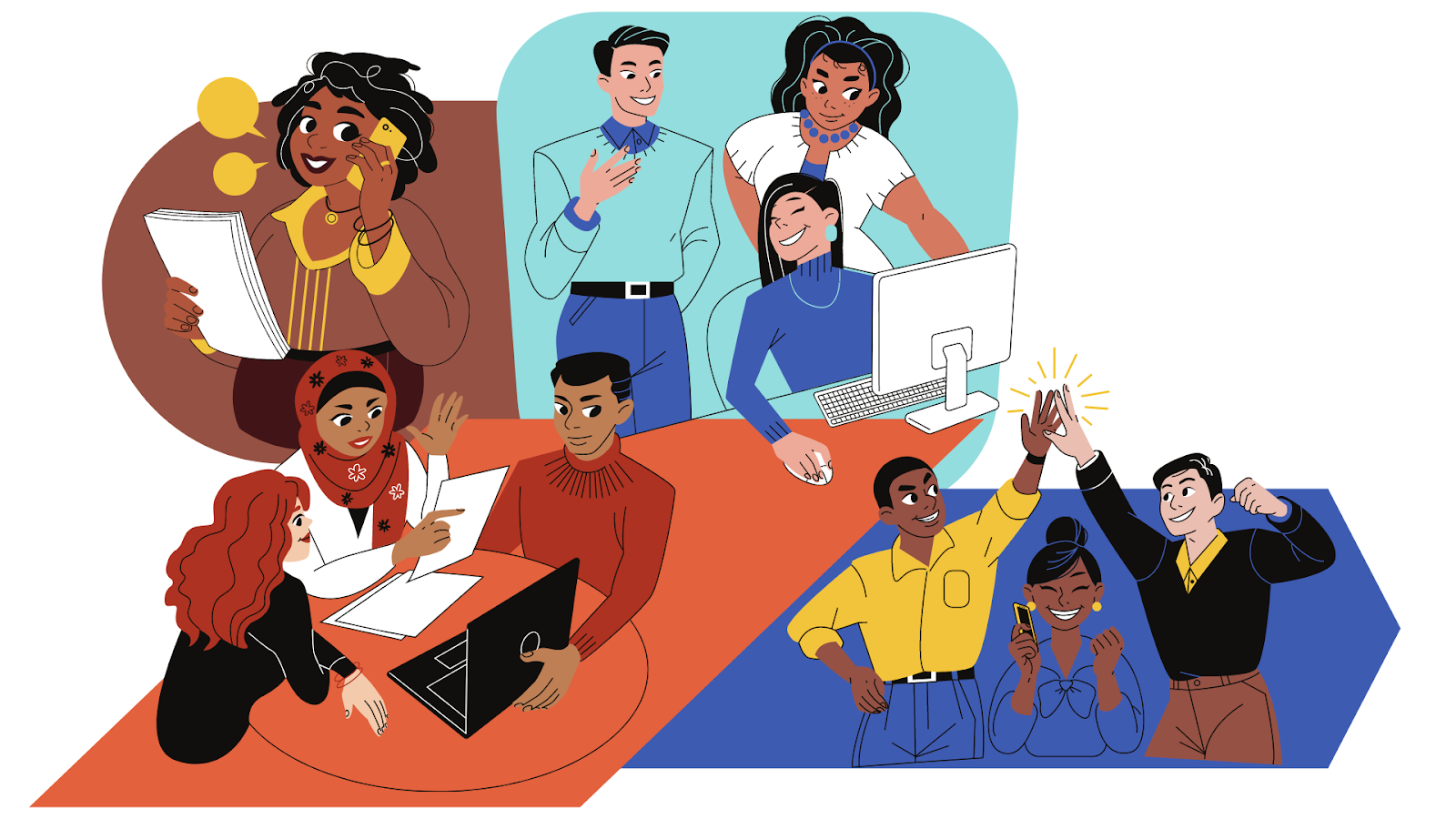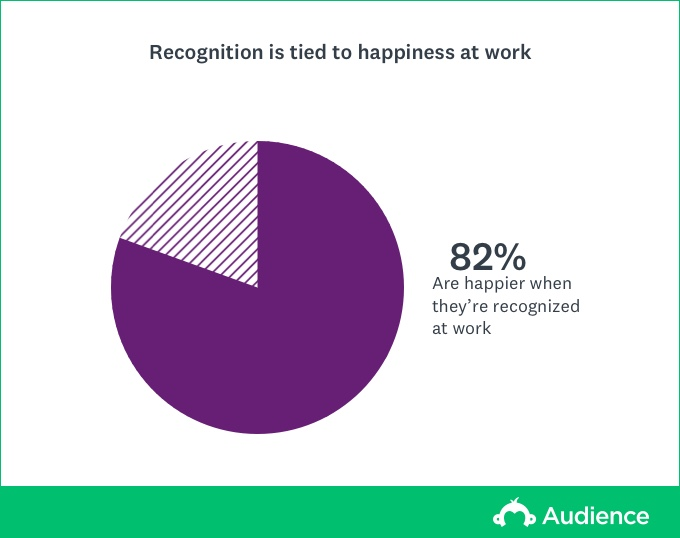
People are at the heart of any company. After all, what is a business without its employees? This is why it is so essential to build a company culture that values and supports the people who work there. To achieve this, a strong peer-to-peer recognition strategy is essential.
HR teams across a range of industries are starting to see the importance of employee recognition. It is just one of many vital HR processes that work to support any great team.
Let this Process Street article be your one-stop shop for all things related to peer recognition! We’ll cover what exactly we mean by peer-to-peer recognition, how it can benefit your company, and six best practices to include in your recognition strategy.
- What is peer-to-peer recognition?
- What are the benefits of peer-to-peer recognition?
- 6 best practices to try now
What is peer-to-peer recognition?
When we think about rewards or recognition in the workplace, we usually think of something given by a boss or leader to their team members. But what if I told you there was another way of doing things? Peer-to-peer recognition shakes up this system to build more mutual and reciprocal relationships between employees.

‘Recognition’ covers anything that celebrates employees for their good work. Here are just a few ways you can recognize your employees:
- Employee of the Month program – A classic! This gives your company a regular opportunity to spotlight an employee. Being a widespread, well-recognized strategy it also looks great on a resume.
- Social media shoutouts – Publicly recognizing good employees on a platform like LinkedIn or Instagram lets them know their work is appreciated. You’re not just sharing it in the workplace, but to your social media followers as well!
- Gift cards or bonuses – This type of recognition may seem shallow but it does offer more flexibility than some other strategies. The recipient can choose to spend that money on whatever kind of reward that they would prefer.
- Celebrating milestones – Everyone knows that persistence is one of the most important qualities a businessperson could have. Recognizing this patience and resilience can go a long way in uplifting your employees.
- Employee recognition certificates – These are often used to celebrate when an employee has learned a new workplace skill, such as coding or first aid training. It recognizes the effort put in by the person to learn that skill and encourages a culture of continuous learning.
We’re sure you can imagine why most people view these as positives, but in this next section, we’ll explain the more specific benefits of peer-to-peer recognition.
What are the benefits of peer-to-peer recognition?
When people know that their efforts are being recognized, they will work even harder to achieve good results. Employees who are more engaged in their work are happier, more productive, and have better relationships with their coworkers.
Employee engagement is super important for elevating your business to the next level. It’s what gets people excited to show up every day – combine this with a great recognition program and you’ve got a workforce that wants to do their job and (most importantly) do it well.
The customer’s perspective
Of course, any discussion about business practices would be incomplete without considering the customer. Fortunately, employees involved in peer-to-peer recognition also carry that collaborative and supportive mindset over to customer service.
A customer service team made up of happy and engaged employees can have a huge positive impact on your CSAT (Customer Satisfaction Score). A CSAT is a measure of how happy your customers are with the retail operations that they have experienced.
Showing that your company values and celebrates its employees also adds to the positive brand image your customer has in their mind. Spread the word about your peer-to-peer recognition programs and consider including them in outreach campaigns.
6 best practices to try now
The right mindset is crucial to successfully introducing peer-to-peer recognition into your workplace. These best practices will stand you in good stead no matter which recognition strategies you choose to include in your program.
1. Set clear goals
Before starting any new employee program, you need to understand what you are hoping to achieve. This is also the case for peer-to-peer recognition. Why should your employees get involved in the recognition programs?
In a way, this is almost like a sales pitch: company-wide programs are only successful if every employee is involved, so step 1 is getting them on board. With the right communication skills, you’ll have everyone signed up in no time!
Setting out what you want to achieve by improving peer recognition is how you can later measure its success. Are you trying to encourage people to learn new skills? Or are you aiming more for collaboration and teamwork?
Whatever your goal is, establish it right at the beginning and work towards it at every stage of the recognition strategy.
Goals focus people’s efforts on achieving specific, measurable things. This in turn contributes to a culture where employees feel successful and appreciated.
2. Make it part of your company culture
Occasional rewards or bonuses are great, but peer recognition needs to be woven right into the fiber of your company to really see the benefits. 46% of job seekers consider workplace culture an important factor when applying for roles.
A culture of recognition means that employees are voluntarily celebrating each other’s achievements each and every day, not just when they’re prompted by a boss or calendar reminder.
You can help build this company culture by including the recognition programs in employee orientation for new hires. Including it from day one will help to make peer recognition more natural in the workplace. Authenticity is key!
3. Celebrate both teams and individuals
People rarely work alone. Recognizing the efforts of teams as well as individual employees shows that you value these collaborative projects. Your company can do this by setting up a live webinar or meeting to celebrate and recognize achievements.
Team tasks work hand-in-hand with peer recognition to help build strong, authentic relationships between employees. Doing your part to create an environment where “if one person wins, we all win” really is an achievable workplace culture.
4. Lead by example
Encourage employees to practice peer-to-peer recognition with a bit of DIY – Do It Yourself! Show that you’re committed to the new programs by using them with your own team members and peers.
5. Be specific
Part of giving authentic peer recognition is avoiding generic compliments or congratulations. “Nice job!” and “I appreciate you doing this!” are still good things to hear, but it’s better if you offer more specific recognition.
This will make the person feel like their efforts are truly being seen and rewarded accordingly. Let them know exactly why you value their work and how they can continue achieving that same success in the future.
Imagine you’re a software developer who just fixed some bugs in the company’s telecommunications app. Coworker A comes up to you and says ‘Great work on the recent project!’, while Coworker B says ‘You really did a brilliant job fixing the telecoms, especially that UI problem. Now we’ve got the best phone system for business yet!’. Not only that, they then endorse your software development skill on your LinkedIn profile.
Both coworkers are showing appreciation for their peer’s achievements. But it is the more specific recognition – and the social media action to support it – that will have a bigger impact.

6. Brainstorm new recognition ideas with employees
Last but certainly not least, the best way to build a successful recognition program is by asking employees what they would like to see. Would they prefer honorary rewards like certificates or more material bonuses like extra PTO? Are they okay with having their achievements shared on social media, or do they want to keep them in the office?
Organize regular meetings where you ask for feedback and suggestions on the current peer recognition culture. These meetings themselves will provide another kind of peer-to-peer interaction where different people’s ideas are heard and validated.
Meetings could be held in person, or hosted through one of the competitors of Zoom. Online communication software is especially important if your team includes people working remotely. Good peer recognition has to include all employees, whether they’re in the office or not.
A structure you could use for these feedback sessions is known as agile scrum. This involves people working together at a fast, reactive pace as opposed to following a pre-set procedure. The benefits of agile scrum include quicker problem-solving and a more collaborative work environment.
Closing notes
There we go! Now you know all about peer-to-peer recognition and the wide range of benefits that it can bring to your employees.
We discussed that the best peer-to-peer recognition practices include teams as well as individuals. They should also be specific to that person or team’s achievements and work towards the goals that you set out for the recognition program.
Last of all, we explained the importance of regular feedback sessions so that peer recognition strategies are constantly evolving to suit the employees as best they can.
Try the recognition practices that we’ve mentioned here to develop a happier, more productive team that supports each other’s success. Make sure to share this article when you tell them all about the new peer recognition programs!
What peer-to-peer recognition practices have you used with your employees? Which have been the most successful? Let us know in the comments!

Grace Lau is the Director of Growth Content at Dialpad. She has over 10 years of experience in content writing and strategy. Currently, she is responsible for leading branded and editorial content strategies. She has also written content for Multibriefs and Brightpearl.







 Workflows
Workflows Projects
Projects Data Sets
Data Sets Forms
Forms Pages
Pages Automations
Automations Analytics
Analytics Apps
Apps Integrations
Integrations
 Property management
Property management
 Human resources
Human resources
 Customer management
Customer management
 Information technology
Information technology





Leks Drakos
Leks Drakos, Ph.D. is a rogue academic with a PhD from the University of Kent (Paris and Canterbury). Research interests include HR, DEIA, contemporary culture, post-apocalyptica, and monster studies. Twitter: @leksikality [he/him]